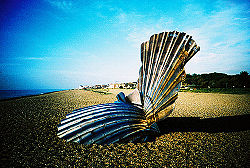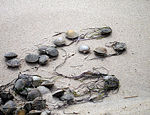Scallop
Scallops are mollusks, which are best known as a popular food source. There are more than 15,000 species, which are about 8 inches in length and have two hard shells (bivalve) covering their body to protect them from predators such as snails, starfish, and fish. There family members are separate into males and females, and some are born males then turns into females. Scallops usually mature at age 3 to 4 years old. Average age for a scallop is about 18 years old or less, but others can live up 20 years or more. They are bivalves, which means they are filter feeders. Which means water goes through the gills and food particles are separated for their food, and goes into there gills. You can find scallops under sand bottoms usually connected to the rocks.
Anatomy
Scallops are bivalve mollusks, they have fan like shells that are really hard. Their shells have characteristics ribs, grooves, and concentric growth rings. Where the two shells meet, they flare out to make a wing. Inside the valves there are a row of tentacles and blue eyes on the the edge of the mantle. The shell is opened and closed by a adductor muscle called the eye. [1] The scallops ovary is in between the intestinal and mantle, which is inside the shell. Ovary is usually paired a paired female hermaphroditic reproductive organ that produces ova in vertebrates, and estrogen. Scallops also have gills between the mantle and the anus, inside the shell. Gills are an organ that helps them breath water, it has filamentous structure in it. Gases are exchanged in this process of breathing. There mantle is between the ovary and gills. Which for scallops is a pair of folding in there body, that creates line for the shell and secretes, making the shell for the scallops. Anus for scallops is between the tentacles and eyes. Which is a opening for the scallops to eliminate solid wastes from there body. The last is the intestinal tract which is between the testis and ovary of scallop. Which is the scallops stomach and intestine, where the food is located and stored.[2]
Reproduction
Scallops has an unusual family members, some are dioecious which means males and females are separate, some scallops are protoandrous and hermaphrodites which means male when young and then switches to female. Red roe is female and white roe is males.Spermantozoa is released into the water during mating season and sinks to the bottom, then after several weeks it hatches and grows in the bottom. Some are short lived and others can live up to 20 years or more.[3] Scallops are bivalves because of there two shells hanging together. Mostly scallops are sexually mature by age 3 to 4 years old. [4]
Ecology
The scallops usually lives in sand bottoms and may be connected to rocks. But they can still swim freely to a different location. Which helps them avoid there predators which are starfish, snails, and fish. Scallops are filter feeders, the water goes into the body and through the gills, where the tiny food particles are trapped and digested. It is called the gill mucus. This process allows other organisms to get fresh water. [5]
Interesting Facts
There are 30 genera and 350 species in the pectinidae family. Many scallops are a food source to human most of the scallops are free living. They swim by opening and closing there shell rapidly. Scallops have adductor muscle and inside their shell has a characteristic central scar that marks the muscle, Their shell helps them to protect themselves from predators. Lots of Scallops can be found in sand, the ocean, or rock bottoms.Scallops also have jewel like eyes which can detect the change of light. The length of a scallop can reach up to 8 inches or larger. They are found all over the worlds ocean, they are popular for there colorful shell. [6]
Gallery
Atlantic Bay scallop
(A. irradians)
Genus: ArgopectenGreat Scallop
(P. maximus)
Genus: Pecten
References
- Scallop Multiple authors, Multiple publishers.
- Scallop Richard Cartensen , Alaska Department of Fish and Game ,12/18/07 .
- Bivalves multiple authors, Advameg Inc, 2007.
- [7] Multiple authors, Delaware Sea Grant.
- Taxonomy and Anatomy Multiple authors, Multiple publisher.
- Pectinidae Wikispecies





